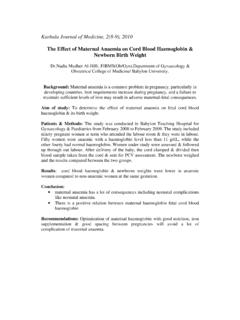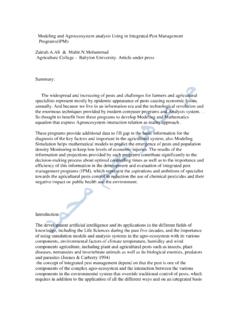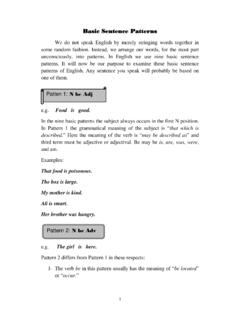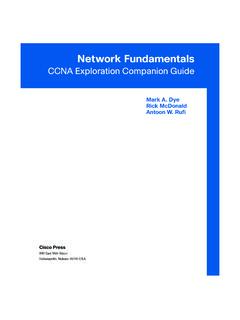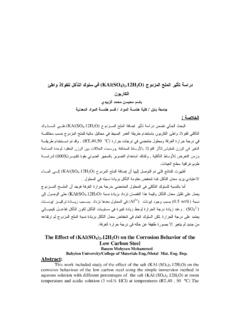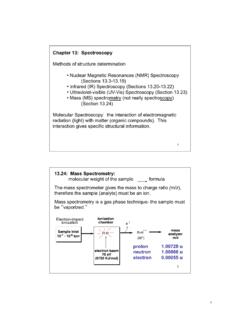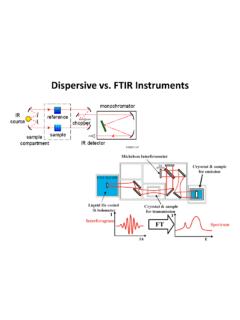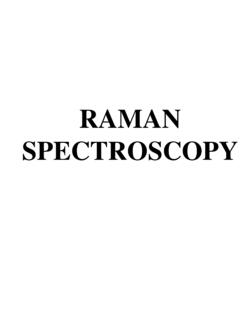Transcription of ULTRAVIOLET AND VISIBLE SPECTROSCOPY
1 ORGANIC CHEMISTRY SPECTROSCOPY of Organic Compounds Prof. Subodh Kumar Dept. of Chemistry Guru Nanak Dev University Amritsar -143005 ( ) CONTENTS IntroductionUltraviolet and VISIBLE SpectroscopyNature of Electronic TransitionsPrinciples of absorption SPECTROSCOPY Spectral MeasurementsSolvent EffectsApplications of Electron SPECTROSCOPY Commercial Applications of UV and VISIBLE SpectroscopyInfrared absorption SpectroscopyHooke s law and absorption of RadiationsModes of Molecular VibrationsOther Factors influencing Vibrational FrequenciesSample PreparationCharacteristic Group Vibrations of Organic Molecules 1 Introduction The molecular SPECTROSCOPY is the study of the interaction of electromagnetic waves and matter. The scattering of sun s rays by raindrops to produce a rainbow and appearance of a colorful spectrum when a narrow beam of sunlight is passed through a triangular glass prism are the simple examples where white light is separated into the VISIBLE spectrum of primary colors.
2 This VISIBLE light is merely a part of the whole spectrum of electromagnetic radiation, extending from the radio waves to cosmic rays. All these apparently different forms of electromagnetic radiations travel at the same velocity but characteristically differ from each other in terms of frequencies and wavelength (Table 1). Table 1: The electromagnetic spectrum Radiation type Wave length , ( ) Frequency = c / , (Hz) Applications radio 10143 x 104 Nuclear magnetic resonance 10123 x 106 Television 10103 x 108 Radar 1083 x 1010 Spin orientation Microwave 1073 x 1011 Rotational Far infrared 1063 x 1012 Near infrared 1043 x 1014 Vibrational VISIBLE 8 x 103 - 4 x x 1014 - x 1014 ULTRAVIOLET 3 x 1031 x 1015X-rays 1 3 x 1018 Electronic Gamma rays 10-23 x 1020 Cosmic rays 10-43 x 1022 Nuclear transitions The propagation of these radiations involves both electric and magnetic forces which give rise to their common class name electromagnetic radiation.
3 In SPECTROSCOPY , only the effects associated with electric component of electromagnetic wave are important. Therefore, the light wave traveling through space is represented by a sinusoidal trace (figure 1). In this diagram is the wavelength and distance A is known as the maximum amplitude of the wave. Although a wave is frequently characterized in terms of its wavelength , often the terms such as wavenumber ( ), frequency ( ), cycles per second (cps) or hertz (Hz) are also used. 21 cycle 1 cycle Adirection of propagationelectric field intensity Figure 1: Wave like propagation of light ( = wavelength , A = amplitude) The unit commonly used to describe the wavelength is centimeters (cm), the different units are used to express the wavelengths in different parts of the electromagnetic spectrum. For example, in the ULTRAVIOLET and VISIBLE region, the units use are angstrom ( ) and nanometer (nm).
4 In the infrared region, the commonly used unit is wavenumber ( ), which gives the number of waves per centimeter. Thus 1 cm = 107 nm = 108 1 = 10-1 nm = 10-8 cm The four quantities wavelength, wavenumber, frequency and velocity can be related to each other by following relationships Wavelength ( ) = 1 / = c / Wave-number ( ) = 1 / = / c Frequency ( ) = c / = c Velocity (c) = = / absorption of Different Electromagnetic radiations by Organic Molecules In absorption SPECTROSCOPY , though the mechanism of absorption of energy is different in the ULTRAVIOLET , infrared and nuclear magnetic resonance regions, the fundamental process is the absorption of a discrete amount of energy. The energy required for the transition from a state of lower energy (E1) to state of higher energy (E2) is exactly equivalent to the energy of electromagnetic radiation that causes transition.
5 E1E2E2 - E1 = E = h v Figure 2: Energy transition for the absorption of any electromagnetic radiation 3 E2 = E = h = h c / Where E is energy of electromagnetic radiation being absorbed, h is the universal Planck s constant, x 10-27 erg sec and is the frequency of incident light in cycles per second (cps or hertz, Hz), c is velocity of light x 1010 cm s-1 and = wavelength (cm) Therefore, higher is the frequency, higher would be the energy and longer is the wavelength, lower would be the energy. As we move from cosmic radiations to ULTRAVIOLET region to infrared region and then radio frequencies, we are gradually moving to regions of lower energies. A molecule can only absorb a particular frequency, if there exists within the molecule an energy transition of magnitude E = h Although almost all parts of electromagnetic spectrum are used for understanding the matter, in organic chemistry we are mainly concerned with energy absorption from only ULTRAVIOLET and VISIBLE , infrared, microwave and radiofrequency regions.
6 ULTRAVIOLET VISIBLE SPECTROSCOPY ( 200 - 800 nm) studies the changes in electronic energy levels within the molecule arising due to transfer of electrons from - or non-bonding orbitals. It commonly provides the knowledge about -electron systems, conjugated unsaturations, aromatic compounds and conjugated non-bonding electron systems etc. Infrared SPECTROSCOPY ( 400-4000 cm-1) studies the changes in the vibrational and rotation movements of the molecules. It is commonly used to show the presence or absence of functional groups which have specific vibration frequencies viz. C=O, NH2, OH, CH, C-O etc. Nuclear magnetic resonance (radiofrequency 60-600 MHz) provides the information about changes in magnetic properties of certain atomic nuclei. 1H and 13C are the most commonly studied nuclei for their different environments and provide different signals for magnetically non-equivalent nuclei of the same atom present in the same molecule.
7 In the present chapter, UV-Vis and Infrared SPECTROSCOPY have been discussed. ULTRAVIOLET and VISIBLE SPECTROSCOPY This absorption SPECTROSCOPY uses electromagnetic radiations between 190 nm to 800 nm and is divided into the ULTRAVIOLET (UV, 190-400 nm) and VISIBLE (VIS, 400-800 nm) regions. Since the absorption of ULTRAVIOLET or VISIBLE radiation by a molecule leads transition among electronic energy levels of the molecule, it is also often called as electronic SPECTROSCOPY . The information provided by this SPECTROSCOPY when combined with the information provided by NMR and IR spectral data leads to valuable structural proposals. Nature of Electronic Transitions The total energy of a molecule is the sum of its electronic, its vibrational energy and its rotational energy. Energy absorbed in the UV region produces changes in the electronic energy of the molecule. As a molecule absorbs energy, an electron is promoted from an occupied molecular 4orbital (usually a non-bonding n or bonding orbital) to an unoccupied molecular orbital (an antibonding or * orbital) of greater potential energy (figure 3).
8 For most molecules, the lowest-energy occupied molecular orbitals are orbitals, which correspond to bonds. The orbitals lie at relatively higher energy levels than orbitals and the non-bonding orbitals that hold unshared pairs of electrons lie even at higher energies. The antibonding orbitals ( * and * ) are orbitals of highest energy. The relative potential energies of these orbitals and vaious possible transitions have been depicted in figure 3. The saturated aliphatic hydrocarbons (alkanes) exhibit only * transitions but depending on the functional groups the organic molecules may undergo several possible transitions which can be placed in the increasing order of their energies viz. n * < n * < * < * < *. Since all these transitions require fixed amount of energy (quantized), an ULTRAVIOLET or VISIBLE spectrum of a compound would consist of one or more well defined peaks, each corresponding to the transfer of an electron from one electronic level to another.
9 If the differences between electronic energy levels of two electronic states are well defined if the nuclei of the two atoms of a diatomic molecule are held in fixed position, the peaks accordingly should be sharp. However, vibrations and rotations of nuclei occur constantly and as a result each electronic state in a molecule is associated with a large n CCCC CO n 1 2 3 4 CCCC 2 3 Figure 3 : Relative energies of orbitals most commonly involved in electronic SPECTROSCOPY of organic molecules number of vibrational and rotational states. At room temperature, the molecules in the ground state will be in the zero vibrational level (G o). This is shown schematically in figure 4. The transition of an electron from one energy level to another is thus accompanied by simultaneous change in vibrational and rotational states and causes transitions between various vibrational and rotational levels of lower and higher energy electronic states.
10 Therefore many radiations of closely placed frequencies are absorbed and a broad absorption band is obtained. When a molecule absorbs ULTRAVIOLET or VISIBLE light of a defined energy, an assumption is made that only one electron is excited form bonding orbital or non-bonding orbital to an anti-bonding orbital and 5all other electrons remain unaffected. The excited state thus produced is formed in a very short time of the order of 10-15 seconds. In accordance with Franck-Condon principle, during electronic excitation the atoms of the molecule do not move. The most probable transition would appear to involve the promotion of one electron from the highest occupied molecular orbital (HOMO) to the lowest unoccupied molecular orbital (LUMO), but in many cases several transitions can be observed, giving several absorption bands in the spectrum. We can have a general view of the possible transitions prevailing in organic compounds.

